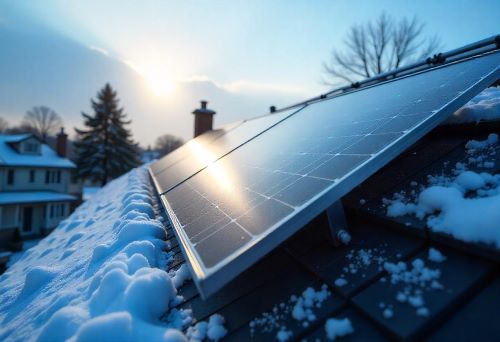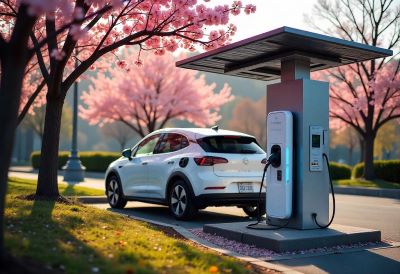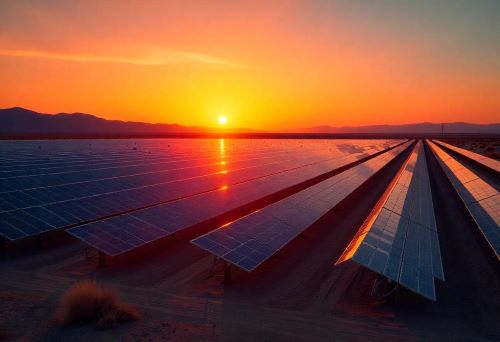Understanding How Solar Panels Convert Sunlight Into Electricity
As the world shifts towards sustainable energy sources, solar energy systems have emerged as a leading solution for clean electricity generation. With India witnessing a 141% rise in solar PV cell imports from China, it’s crucial to understand what photovoltaic (PV) cells are and how they power our homes and industries through solar panels.

Two Fundamental Methods of Electricity Generation
Electromagnetic Induction vs. Photovoltaic Effect
There are fundamentallyRBI to Conduct ₹1 Lakh Crore 7-Day Variable Rate Reverse Repo Auction on July 4
RBI Steps in to Absorb Surplus Liquidity Amid Banking System Excess
In a significant move to manage the surplus liquidity in the banking system, the Reserve Bank of India (RBI) has announced a ₹1 lakh crore 7-day Variable Rate Reverse Repo (VRRR) auction to be conducted on July 4, 2025. The auction will be held between 10 AM and 11 AM, with the reversal date fixed for July 11, 2025.
This decision aligns with the central bank’s broader objective to maintain systemic liquidity around 1% of Net Demand and Time Liabilities (NDTL).
Why RBI is Conducting VRRR Auction on July 4?
According to the RBI press release issued on July 3, the step is being taken after reviewing the “current and evolving liquidity conditions” in the financial system. As per latest RBI data, the surplus liquidity in the banking system stood at ₹3.75 lakh crore as of July 2, 2025—much higher than the comfortable zone targeted by the central bank.
What is Variable Rate Reverse Repo (VRRR)?
A Variable Rate Reverse Repo auction is a monetary policy tool used by the RBI to absorb excess liquidity from the banking system. Unlike fixed rate reverse repo operations, VRRR allows banks to bid at variable interest rates, helping RBI determine the most efficient rate to mop up surplus funds.
Key Details of RBI’s ₹1 Lakh Crore VRRR Auction
Auction Date: July 4, 2025 (Friday)
Auction Window: 10:00 AM to 11:00 AM
Reversal Date: July 11, 2025
Total Auction Size: ₹1 lakh crore
Type: 7-day Variable Rate Reverse Repo
Purpose: Liquidity absorption from the banking system
RBI’s Strategy: Manage Liquidity and Anchor Inflation
The RBI’s decision to conduct more frequent and larger VRRR auctions is aimed at striking a balance between maintaining liquidity and anchoring inflation expectations.
Reasons Behind the Move:
Surplus liquidity of ₹3.75 lakh crore as of July 2
Excess funds could fuel inflationary pressures
Ensuring liquidity remains aligned with policy targets
Supporting transmission of monetary policy rates
Liquidity Surplus – A Growing Concern for RBI
Over the past few weeks, the Indian banking system has seen a steady build-up of liquidity. While surplus liquidity helps in lowering interest rates and supporting credit growth, excess liquidity beyond acceptable thresholds can distort the monetary transmission mechanism.
Sources of Surplus Liquidity:
Advance tax refunds by the government
Capital inflows and forex operations
Government spending patterns
Reduced credit offtake in early FY26
Previous VRRR Auctions by RBI – A Trend in the Making
This is not the first time RBI is taking such a step. On July 1, Moneycontrol reported that RBI was planning more frequent VRRR auctions to ensure systemic liquidity remains close to 1% of NDTL.
Recent Actions by RBI:
Series of short-term VRRR auctions over the last 3 months
Continuously absorbing excess funds through variable rate tools
Prioritizing calibrated liquidity management to avoid volatility
Impact of RBI’s VRRR Auctions on Markets and Banks
The auction on July 4 is expected to draw substantial participation from banks, especially those with surplus funds. It will also have an immediate impact on overnight money market rates, potentially bringing short-term rates in line with policy corridors.
Likely Effects on Market:
Short-term interest rates may inch higher
Banking system liquidity will temporarily reduce
Encourages banks to better utilize idle funds
Could tighten short-term lending conditions slightly
Expert Views on RBI’s ₹1 Lakh Crore VRRR Move
Financial analysts and economists believe that the RBI’s auction is a pre-emptive step to ensure that liquidity-driven inflation risks are avoided.
“This VRRR auction is part of a broader RBI strategy to normalize liquidity without resorting to blunt instruments. It also shows RBI’s preference for maintaining fine-tuned control over money market conditions,” said an economist at a private bank.
RBI’s Liquidity Management – A Balancing Act
The Reserve Bank of India has been cautiously navigating the post-pandemic economic landscape. With elevated global uncertainty, volatile crude prices, and domestic inflation risks, liquidity management remains one of the core pillars of RBI’s monetary policy framework.
RBI’s Monetary Tools for Liquidity Management:
VRRR auctions
Repo and Reverse Repo operations
Open Market Operations (OMOs)
Standing Deposit Facility (SDF)
Conclusion: RBI Tightens Liquidity, But With Precision
With this ₹1 lakh crore 7-day VRRR auction, the RBI is sending a clear message to markets — that while it supports growth, it will not compromise on monetary discipline. Absorbing surplus funds at this scale indicates the central bank’s commitment to liquidity alignment and price stability.
As more such auctions are expected in coming weeks, banks and financial institutions will need to stay alert and optimize their liquidity positions accordingly.

Keywords for SEO Optimization
RBI VRRR auction July 4
₹1 lakh crore reverse repo auction
RBI liquidity management 2025
Variable rate reverse repo auction by RBI
Surplus liquidity in banking system
RBI monetary policy tools
Liquidity absorption by RBI
NDTL and RBI reverse repo
RBI July 2025 liquidity update two ways to generate electricity:
Electromagnetic Induction: Discovered by Michael Faraday in 1821, this method involves generating electricity through the movement of a conductor in a magnetic field. It remains the primary technique used globally, especially in thermal and hydroelectric power plants.
Photovoltaic (PV) Cells: The photovoltaic effect, first observed by Alexandre Edmond Becquerel in 1839, involves converting sunlight directly into electricity using semiconductors like elemental silicon.
What Are Solar Photovoltaic (PV) Cells?
The Building Blocks of Solar Panels
PV cells are semiconductor devices that absorb photons (light particles) and release electrons, creating an electric current. These cells are assembled into solar panels, which are then installed on rooftops, solar farms, or remote off-grid locations.
Breakthroughs by Einstein (photoelectric effect) and Jan Czochralski (single-crystal silicon) helped develop the first efficient solar cells in 1954 at Bell Labs.
How Solar Panels Convert Sunlight Into Power
From Photons to Electricity – A Step-by-Step Process
Semiconductors like silicon are poor conductors at room temperature but become conductive when exposed to light or heat.
Electrons in silicon jump from the valence band to the conduction band when they absorb energy from sunlight.
This transition creates a flow of electric current, which is captured and directed into power systems.
⚡ Keyword Focus: How solar energy works, photovoltaic cells, solar panel working, clean energy science, solar cell electricity generation.
Band Gap and Efficiency Limitations
Why Only Half of Solar Spectrum Is Useful
Only about 49.6% of the solar spectrum can be utilized by silicon-based PV cells:
20.2% of photons have too little energy to generate electricity.
30.2% of photons have too much energy, leading to waste as heat.
This leads to a theoretical efficiency ceiling known as the Shockley-Queisser limit, which is around 33.7% for single-junction silicon cells.
Alternative PV Materials and Their Limitations
Beyond Silicon: GaAs, CdTe, and CIS
Other semiconductors like Gallium Arsenide (GaAs), Cadmium Telluride (CdTe), and Copper Indium Selenide (CIS) can absorb different parts of the solar spectrum but come with challenges:
Scarcity and cost
Environmental toxicity
Manufacturing complexity
Hence, crystalline silicon remains the most widely used material for solar PV panels globally.
The P-N Junction: Heart of Solar Electricity Generation
Creating a Driving Force for Electron Flow
Doping silicon with phosphorus and boron creates a p-n junction, which acts like a built-in electric field.
When sunlight strikes the cell, this junction causes electrons to flow, just like a battery.
Connecting an external load completes the circuit, powering devices or storing electricity in batteries.
Real-World Efficiency of Solar Panels
Lab vs. Commercial Performance
Despite theoretical potential, practical efficiency is lower due to several real-world factors:
Heat loss (7%) as panels operate at 30–40°C above ambient.
Saturation effect (10%) due to imbalanced electron-hole movement.
DC to AC conversion loss in inverters.
Uneven sunlight and shading on different cells.
🔋 Efficiency Breakdown:
Theoretical Efficiency: 33.7%
Best Lab Cells: ~25%
Best Commercial Modules: ~20%
Photosynthesis (For Comparison): 3–6%
Types of Solar PV Technologies
First, Second, and Third Generations
First-Gen: Thick crystalline silicon wafers (~200 µm)
Second-Gen: Thin-film silicon (1–10 µm)
Third-Gen: Tandem and multi-junction cells, including quantum dots and organic PVs
Some third-gen solar cells have exceeded Shockley-Queisser limits, achieving up to 42% theoretical efficiency.
How Solar Panels Get Their Blue Color
Anti-Reflection Coating Technology
Silicon naturally reflects sunlight.
A thin transparent anti-reflective layer (tin oxide or silicon nitride) is added to absorb more sunlight and give solar panels their iconic blue hue.
The Energy-Intensive Production Process
From Silicon Purification to Solar Cell Assembly
Czochralski process purifies silicon to 99.9999% purity.
Ingot slicing into wafers results in 20% material loss.
Ribbon silicon technology aims to reduce waste and costs.
Amorphous silicon cells, while cheaper, require hydrogen doping to improve performance.
India’s Growing Solar Ambition
Imports from China and Domestic Manufacturing Push
India’s 141% rise in PV cell imports from China highlights growing demand for solar energy. However, this is also linked to domestic PV module manufacturing ramping up to meet the nation’s renewable energy goals.
Conclusion: What Solar Energy Can and Cannot Do
Solar’s Role in India’s Renewable Future
✅ What Solar Can Do:
Generate electricity without emissions
Power off-grid areas with standalone PV systems
Reduce dependency on fossil fuels
Enable innovations in solar heating, cooling, and desalination
❌ What Solar Cannot Do (Yet):
Work efficiently during nighttime or cloudy days without storage
Fully replace fossil fuels without energy storage solutions
Overcome cost and efficiency challenges without tech innovation

📈 The Future of Solar Energy in India
With falling costs (from $4–5/watt in 2010 to $1.27/watt in 2023) and better solar PV efficiency, India is poised to lead in solar energy adoption. Continuous research, innovation, and policy support are key to making solar power a mainstream energy source.





